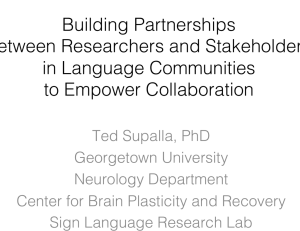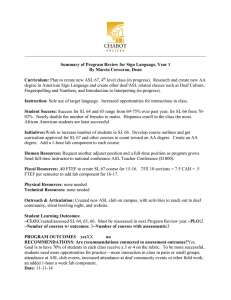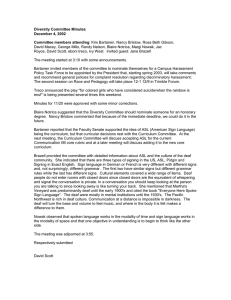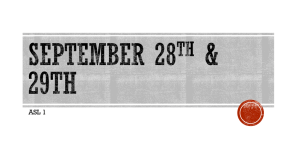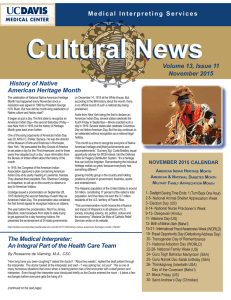Building Partnerships between Researchers and Stakeholders in Language Communities to Empower Collaboration
advertisement
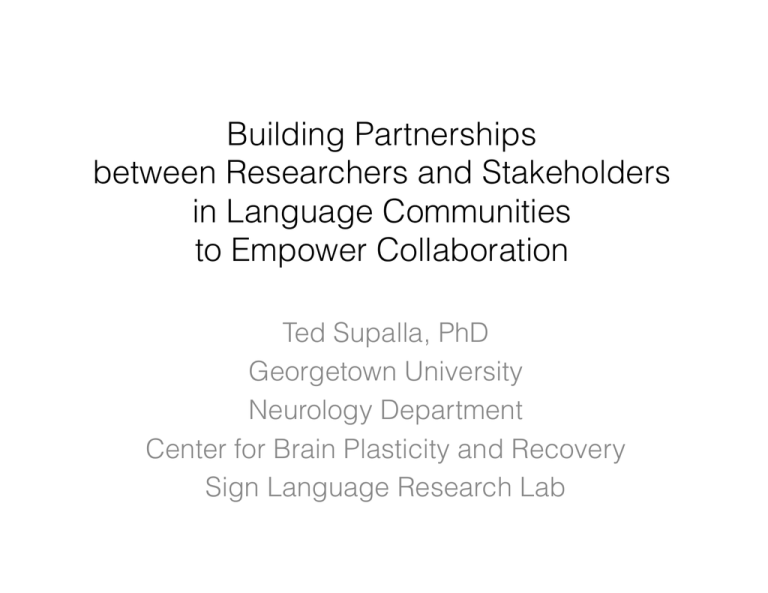
Building Partnerships between Researchers and Stakeholders in Language Communities to Empower Collaboration Ted Supalla, PhD Georgetown University Neurology Department Center for Brain Plasticity and Recovery Sign Language Research Lab American Sign Language Es$ma$on of ASL popula$on: 1 million • 500,000 Deaf & Hard of Hearing • 500,000 Offspring (Deaf & Hearing) • Source: SIPP (2001), Gallaudet Research Ins$tute, CPS (2003), NCDP (1972) Personal Background 1993 W O R L D F E D E R AT I O N O F T H E D E A F SIGN WiiOyAGE 1' ! . ! II I i I ,ll 1 ■ ' by the WFD Scientific Commission on Sign Language Ted Supalb; United States (President) Ritva Bergmann, Denmark Clark Denmark, United Kingdom Markka Jokinen, Finland Odd-Inge Schroeder, Norway Manfa Suwanarat, Thailand Challenge Common concern among Heritage SL stakeholders: How to ensure sustainability and quality assurance? Example: Interpreter Imposter at Nelson Mandela memorial Sign language heritage prone to fragmentation • Stakeholders versus language policy in society • Policy driven by “Restoring the Deaf to Society” Research Background Neuroscience Humanities Techniques for Studying Sign Language Use Neuroscience Humanities Also Using an Archaeological Approach! LSF 1760 ASL 1817 De L Epee Clerc Challenge: To fill a large void in our collective memory Shedding Light on the Dark Period LSF 1760 ASL 1817 De L Epee Clerc 1910-1920 New Technology for Browsing Through Historical ASL Films and Books Rapid access to historical sign language tokens Early stewardship effort George Veditz, 1913 Civic leader and educator Going back 100 years... Revealing the NAD’s Language Plan J. Schuyler Long History of sign language in Europe Literary Society " in America" In early 20th Century" Oratory traditions initiated in France" during the 19th Century" Sign Language Growth Yet no plan for revitalizing our infrastructure So we need to consider alternate models for passing on the language to future generations Empowering collabora$ons to support sign language stewardship • Our community has commi[ed itself to measures that safeguard our sign language heritage. We nourish and steward its journey through cycles of neglect or oppression. • At the same $me, we need to be[er understand our history of struggles and compe$ng ideas. Outreach to Stakeholders in Sign Language Communities To empower collabora$on for introducing this unique heritage to children and parents, thus enlightening society. MOOC course offering in Fall 2016 “Sign Language Structure, Learning & Change” Fundamental message: The forma$on of sign language through $me is like the forma$on of other languages of the world. Acknowledgements • NEH fellowships • NIH and NSF Grants BCS0925073 and BCS-­‐1455756 • Thanks to: – My co-­‐author Pa[y Clark – School and University Archivists – Research team at Georgetown University
